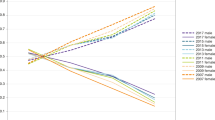Abstract
The lack of diversity in physics and astronomy PhD programmes is well known but has not improved despite decades of efforts. PhD bridge programmes provide an asset-based model to help overcome the societal and disciplinary obstacles to improving access and inclusion for students from underrepresented groups and are beginning to show some success. We describe several well-known PhD bridge programmes in the United States and discuss lessons learned from their experiences. Many of these lessons can be extended more broadly to physics and astronomy PhD programmes to increase access, diversity and inclusion.
This is a preview of subscription content, access via your institution
Access options
Access Nature and 54 other Nature Portfolio journals
Get Nature+, our best-value online-access subscription
$29.99 / 30 days
cancel any time
Subscribe to this journal
Receive 12 digital issues and online access to articles
$119.00 per year
only $9.92 per issue
Buy this article
- Purchase on Springer Link
- Instant access to full article PDF
Prices may be subject to local taxes which are calculated during checkout

Cal-Bridge Program
Similar content being viewed by others
References
Integrated Postsecondary Education Data System (US Department of Education, Institute of Education Sciences, National Center for Education Statistics, 2019); https://ncsesdata.nsf.gov/webcaspar/
First-Generation Students in Higher Education (PNPI, 2018).
Posselt, J. Inside Graduate Admissions: Merit, Diversity, and Faculty Gatekeeping (Harvard University Press, 2016).
Posselt, J. R. Trust networks: a new perspective on pedigree and the ambiguities of admissions. Rev. Higher Educ. 41, 497–521 (2018).
Miller, C. & Stassun, K. Nature 510, 303–304 (2014).
Bastedo, M. N. & Jaquette, O. Running in place: low-income students and the dynamics of higher education stratification. Educ. Eval. Policy Anal. 33, 318–339 (2011).
Langin, K. A wave of graduate programs drops the GRE application requirement. Science Magazine (29 May 2019); https://www.sciencemag.org/careers/2019/05/wave-graduate-programs-drop-gre-application-requirement
Miller, C. W., Zwickl, B. M., Posselt, J. R., Silvestrini, R. T. & Hodapp, T. Typical physics Ph.D. admissions criteria limit access to underrepresented groups but fail to predict doctoral completion. Sci. Adv. 5, eaat7550 (2019).
Hall, J. D., O’Connell, A. B. & Cook, J. G. Predictors of student productivity in biomedical graduate school applications. PLoS One 12, e0169121 (2017).
Potvin, G., Chari, D. & Hodapp, T. Investigating approaches to diversity in a national survey of physics doctoral degree programs: the graduate admissions landscape. Phys. Rev. Phys. Educ. Res. 13, 020142 (2017).
Rudolph, A. L. Cal-Bridge: creating pathways to the PhD for underrepresented students in physics and astronomy. Phys. Today 72, 50–57 (2019). 10.
Posselt, J. R. & Grodsky, E. Graduate education and social stratification. Annu. Rev. Sociol. 43, 353–378 (2017).
Pyne, J. & Grodsky, E. Inequality and opportunity in a perfect storm of graduate student debt. Sociol. Educ. https://doi.org/10.1177/0038040719876245 (2018).
Milkman, K. L., Akinola, M. & Chugh, D. What happens before? A field experiment exploring how pay and representation differentially shape bias on the pathway into organizations. J. Appl. Psychol. 100, 1678 (2015).
Brunsma, D. L., Embrick, D. G. & Shin, J. H. Graduate students of color: race, racism, and mentoring in the white waters of academia. Sociol. Race Ethnic. 3, 1–13 (2017).
Stassun, K. G. et al. Am. J. Phys. 79, 374–379 (2011).
Expanding Underrepresented Minority Participation: America’s Science and Technology Talent at the Crossroads (The National Academies, 2011).
Stassun, K. G. Mercury. 34, 22–27 (2005).
Hodapp, T. & Woodle, K. S. Phys. Today 70, 50–56 (2017).
Sowell, R. S., Zhang, T. & Redd, K. Completion and Attrition: Analysis of Baseline Program Data from the Ph.D. Completion Project (Council of Graduate Schools 2008).
Rudolph, A. et al. Final report of the 2018 AAS task force on diversity and inclusion in astronomy graduate education. Bull. Am. Astron. Soc. (2019).
Harter, J. K., Schmidt, F. L. & Keyes, C. L. in Flourishing: Positive Psychology and the Life Well-Lived (American Psychological Association, 2003)
Ely, R. J., Padavic, I. & Thomas, D. A. Organization Studies. 33, 341–362 (2012).
Norman, D. et al. in Seeking Solutions: Maximizing American Talent by Advancing Women of Color in Academia: Summary of a Conference (The National Academies, 2013).
Author information
Authors and Affiliations
Contributions
All authors contributed equally to this work.
Corresponding author
Ethics declarations
Competing interests
The authors declare no competing interests.
Additional information
Publisher’s note Springer Nature remains neutral with regard to jurisdictional claims in published maps and institutional affiliations.
Rights and permissions
About this article
Cite this article
Rudolph, A.L., Holley-Bockelmann, K. & Posselt, J. PhD bridge programmes as engines for access, diversity and inclusion. Nat Astron 3, 1080–1085 (2019). https://doi.org/10.1038/s41550-019-0962-1
Received:
Accepted:
Published:
Issue Date:
DOI: https://doi.org/10.1038/s41550-019-0962-1
This article is cited by
-
Doctoral advisor selection processes in science, math, and engineering programs in the United States
International Journal of STEM Education (2023)


